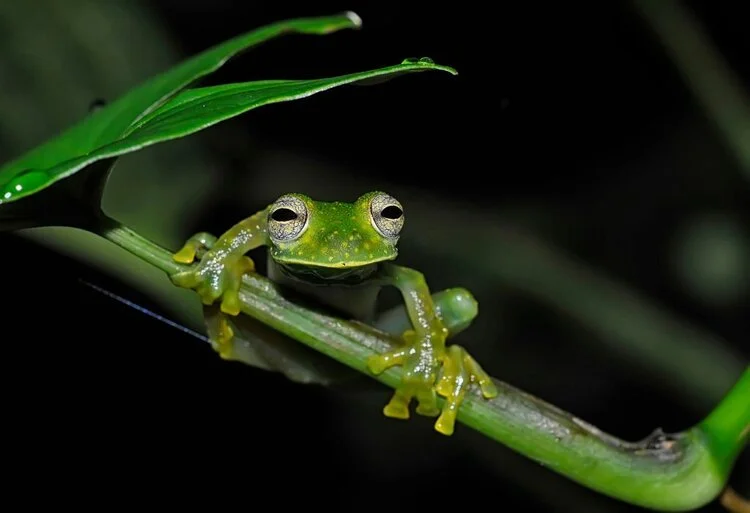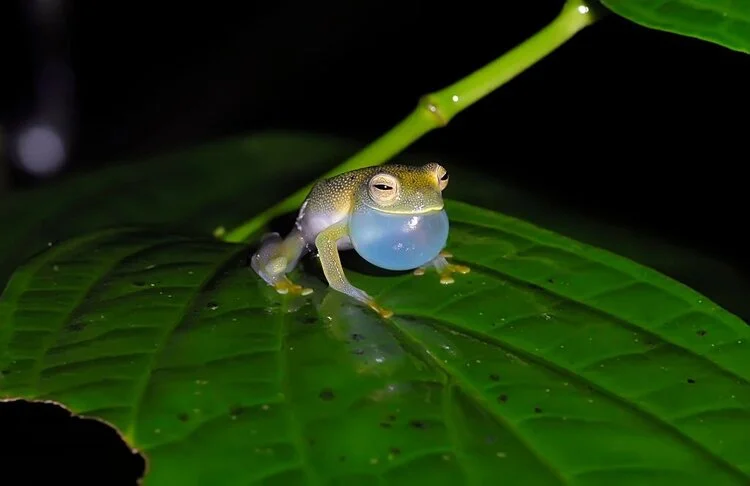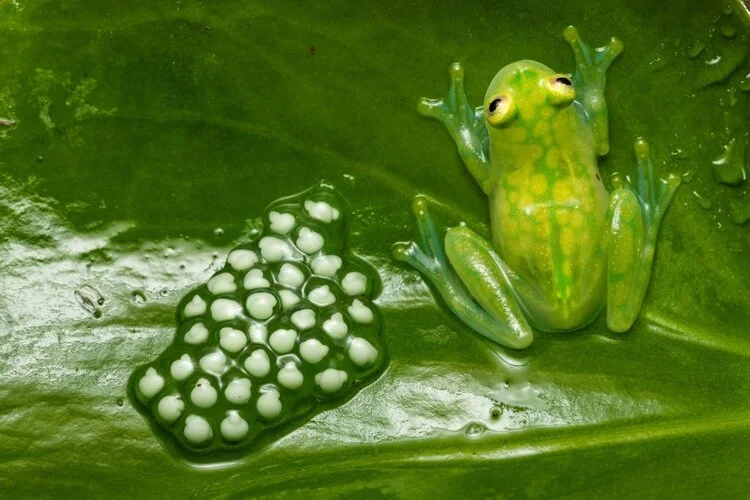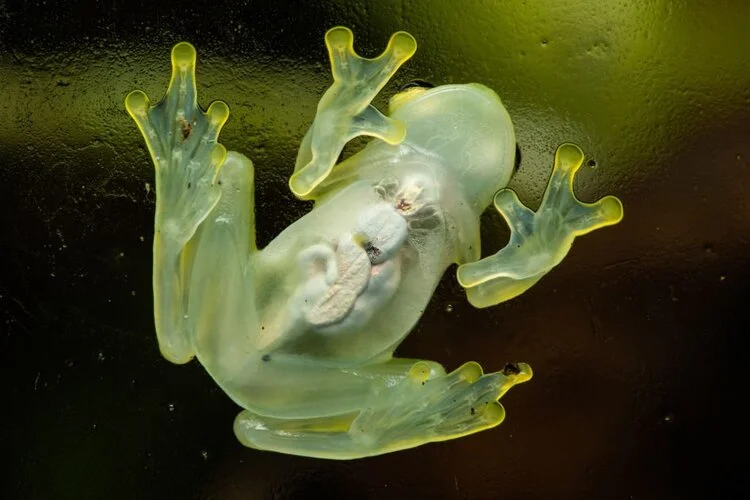Glass frogs are a beautiful species, highly coveted for their transparent skin. However, they are not as readily available as other frog species, and interested owners must be careful not to accidentally buy an endangered or vulnerable variety accidentally. This is not the only challenge these frogs present, though: they also have very specific care requirements and are easily affected by changing enclosure conditions. Additionally, there are several health concerns that owners need to be wary of. Because of this, only moderate to highly experienced owners should purchase this frog.
| Common Name: | Glass frog |
| Scientific Name: | Centrolenidae |
| Natural Habitat: | Central America & South America |
| Adult Size: | 1” or smaller |
| Lifespan: | 10 – 14 Years |
| Diet: | Insects |
| Experience Level: | Moderate |
| Enclosure Size: | 20 Gallons (Minimum) |
Reptile Overview
Glass frogs are highly remarkable and desirable for their transparent or translucent skin, through which you can see the frog’s organs. Where they are not transparent, they are a light green with spots.
The specific coloring depends on the species, as does the size; but generally, these frogs grow to around one inch.
They need at least a 20-gallon enclosure, with more vertical space than horizontal space. The enclosure should be glass or acrylic, with a mesh lid.
Trees, branches, and other foliage (live or fake) are necessary, since this frog prefer to spend its time up high in vegetation.
These frogs need a temperature level of 72 and 78 degrees Fahrenheit and steady humidity levels of 50% to 70%. They will also need a 12-hour light cycle.
During the night is when these frogs are most active, and this is also when they prefer to eat. They are insectivores, although their diet should also be supplemented with calcium.
Appearance
As the name hints, the most significant characteristic of glass frogs are the transparent skin. Depending on the species, the skin may actually be translucent or opaque.
Additionally, the skin’s transparency or translucency may be limited to specific areas of the frog’s body. Some are see-through along the backs and stomachs, while others are just see-through in one of these areas.
The transparency or translucency may also be affected by the time of day.

Glass frogs are generally light green, although the shade may be lighter or darker. These frogs have small spots that may be white, yellow, blue, or black.
These frogs are extremely small, usually around or under an inch. They may grow to 0.7 – 1.2 inches long (approximately 20 – 30 millimeters). Some species may grow larger, but not by much.
Male frogs are smaller than females.
Price & Availability
Glass frogs range in price from roughly $40 to more than $100. The price greatly depends on the species, as well as the coloring, size, age, and gender.
Facts about glass frogs are readily available, but much of the information is about wild specimens, not captive frogs. This is because many people are unsure about whether you can have a glass frog as a pet.
You can keep a glass frog as a pet, but you should be careful. Many glass frogs are listed as Critically Endangered, Endangered, and Vulnerable.
Because these species are becoming increasingly rare, they are also the target of poachers who illegally trap and traffic them into the pet trade. You may accidentally be supporting these illegal practices if you do not buy from a reputable breeder.
As a result, interested owners must be extremely careful to screen potential breeders and ensure their glass frogs are truly captive-bred, and not wild-caught. Glass frogs are not rare as a whole, but only certain species are available in the pet trade.
Do your research to make sure you are buying a species that is not endangered or vulnerable.
Behavior & Temperament
Glass frogs are cute and docile, but not overly active or tactile. They are not a species that should be handled frequently.
If you do need to handle your frogs, thoroughly wash your hands before and after. Frog skin is absorbent, so any lotions, perfumes, oils, etc. will transfer.
Glass frogs are not active during the day, and instead reserve their energy for nighttime. Even so, owners may not see them moving a lot at dusk or at night.
The exception to this is when glass frogs are stalking prey. They actively follow insects or other prey and them leap on them.
For the best chance at seeing your frogs move around, place the enclosure in a quiet and peaceful area. Then, you can unobtrusively observe your frogs as they climb and move around the enclosure.
They are also not very vocal outside of mating season. During this time, males may make mating calls. Females are typically quiet.
Lifespan
These transparent frogs live anywhere from 10 to 14 years in captivity. Their lifespan is greatly reliant on the degree of care they receive, including their enclosure.
To give your glass tree frog the longest life possible, ensure they have a high quality of life. This means adhering to the temperature, humidity, lighting, and other care requirements for your frog.
Enclosure
Glass frogs need an enclosure that is at least 20 gallons. Within a 20-gallon enclosure, you can house two females and one male.
For each additional pair, you will need to add another ten gallons. If you have multiple males, be aware: they are extremely territorial, especially during mating season.
Exo Terra Glass Terrarium Tank – 24 x 18 x 18 Inches
Essentially, this equates to at least five gallons of vertical leaf space per frog. Note that this does not include the open space at the bottom of the enclosure (i.e., the substrate floor).
If you have males and females in your enclosure, pay specific attention to the males. Make sure they are not unduly harassing the females.
These frogs are nocturnal, meaning that they are most active at dusk and during the night.
They are also arboreal, which means they prefer living higher up in vegetation and trees. Because of this, the enclosure should have more vertical height than horizontal space.
Additionally, these frogs are riparian, which means that they traditionally live along streams or other bodies of moving water.
The enclosure should mimic the frog’s natural habitat as closely as possible. Owners should research their specific frog’s habitat in order to accomplish this, since each species is slightly different.
In general, your enclosure should have lots of plants, either living or fake, and branches to allow for climbing.
There should also preferably be a waterfall or stream feature, to recreate moving water. Alternatively, you can create a pool of water at the bottom of the enclosure and add a miniature wavemaker or other equipment to keep the water moving.
A more cost-effective option is to create the pool of water and set up a drip system over the pool.
Temperature & Lighting
Temperatures should be kept between 72 and 78 degrees Fahrenheit. If possible, establish different temperature zones in the enclosure so that your frog can regular their body temperature.
VIVOSUN Reptile Heat Mat with Digital Thermostat
You can maintain these temperatures using heat bulbs and under-tank heating mats. If you use bulbs, make sure they are not pressed directly against the tank, so that your frogs can’t get too close and burn themselves.
Make sure not to using heating rocks or any other heating elements directly in the tank. If your frog touches these, they could suffer serious burns.
Glass frogs need a regular 12-hour light cycle. This means they need 12 hours of light and 12 hours of darkness.
Keep in mind, this is a general rule of thumb. Make sure to research your species to see if they have different light requirements.
Humidity
Humidity levels need to be kept between 50% and 70%. Regular mistings or a misting system can ensure these levels remain stable.
Including a layer of sphagnum moss in the substrate can also help maintain humidity.
Galápagos Terrarium Sphagnum Moss
A source of ventilation is necessary in warm, humid environments. The air needs to be continually circulated and refreshed in order to prevent health issues.
This can be a delicate balance to strike. The enclosure needs ventilation, but not so much that it dries out your frog or the plants.
An easy way to accomplish this is to use a mesh screen over your enclosure instead of a glass screen. Alternatively, get an enclosure that has ventilation holes already included.
Use a hygrometer to measure your humidity levels and ensure they stay balanced. You can also use a ‘smell test’ – that is, your enclosure should smell earthy and fresh.
Diet
Glass frogs primarily eat insects in captivity. Crickets are a good source of protein found at most pet stores, including pinhead sizes.
Additional food sources could include flies, spiders, and moths. However, these may not be as readily available.
Despite this, you should try to feed your frog a varied diet. This includes supplements and vitamins, as needed. Calcium should be included in the diet.
Zoo Med Calcium With Vitamin D3 Reptile Food
Ensure all food is captive-bred, not wild-caught. Feeding translucent frogs insects you found outside could introduce diseases or other threats to your frog’s health.
You should release the insects into the frog’s enclosure. Letting them track appropriately-sized live prey will provide exercise and enrichment.
Glass tree frogs eat prey by jumping at them with an open mouth. Their accuracy is well known; if your frog is having trouble tracking or jumping on prey, consult a veterinarian.
Because these frogs are nocturnal, they prefer to eat in the evening or at night. To encourage a healthy appetite, owners should stick to this pattern.
These frogs may also be more willing to eat if prey is provided near the bottom of the enclosure. Many wild specimens have been observed eating along river banks, where insects are abundant.
Potential Health Issues
Nutritional deficiencies are common with glass frogs. This is not because they are picky eaters, but rather because some owners find it difficult to source multiple, safe insects.
Another issue leading to nutritional problems is a calcium deficiency. This is why calcium supplements should be included, typically dusted over the insects prior to feeding.
A parasitic disease that often affects glass tree frogs is known as ‘red leg,’ because it causes reddening of the skin. Additional symptoms include lethargy and lack of appetite.
Fungal diseases are also common, usually caused by improper enclosure setups.
Keeping your enclosure clean (i.e., spot cleaning and doing regular deep cleans) is one of the best preventative care methods.
If you suspect your frog is ill, schedule an appointment with a veterinarian. If possible, you should also isolate the affected frog so that the potential illness does not spread to the others.
Breeding
Specific breeding practices will vary depending on the species. However, most have breeding behaviors that are triggered by the rainy season.

Besides simulating a rainy season, you should also make sure the enclosure is on the high end of the humidity scale.
If males begin making mating calls, you will know you have been successful at creating the right conditions. These mating calls usually sound like high-pitched whistles, trills, or peeps.
When courting, males typically sit near the bodies of water and make the mating calls. If a female approaches, the male will jump on her back and mate with her. The mating may last for several hours.
Eggs clutches have 20 – 30 eggs. Eggs are laid either underneath or on vegetation overhanging water, or else on vegetation that is close to water.

The behavior of the frogs varies depending on the species. Some species guard the eggs fiercely, while others are attentive but not protective. Typically, it is the males that watch over the eggs.
Eggs usually hatch within two weeks.
Conclusion
Although glass tree frogs are beautiful and have an unusual appearance, they have very specific care requirements and can have a delicate constitution. Because of this, interested owners should have at least moderate experience with frogs or other reptiles or amphibians. But if you are confident that you can meet this frog’s care requirements, you will find great joy in watching this frog interact with its enclosure. They are quiet and not overly entertaining, but their appearance gives them a gentle grace nonetheless, which is compelling to watch. This is especially true when they are hunting prey or climbing, two periods when these frogs are most active.







